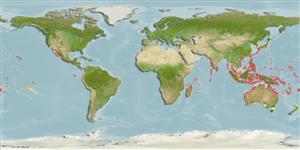>
Centrarchiformes (Basses) >
Kuhliidae (Aholeholes)
Etymology: Kuhlia: Because of Heindrich Kuhl, 1797-1821; researcher also with lizards (Gekkonidae).
Eponymy: Dr Heinrich Kuhl (1797–1821) was a German naturalist and zoologist. [...] (Ref. 128868), visit book page.
More on author: Lacepède.
Environment: milieu / climate zone / depth range / distribution range
นิเวศวิทยา
เกี่ยวกับทะเล,น้ำเค็ม; น้ำจืด; กร่อย เกี่ยวกับหินโสโครก; ปลาที่อพยพจากแหล่งน้ำจืดไปวางไข่ในน้ำเค็ม (Ref. 51243); ระดับความลึก 0 - 5 m (Ref. 86942). Tropical; 20°C - 26°C (Ref. 2060)
Africa to Asia and Oceania: East Africa to Samoa, north to the Ryukyu Islands, south to Queensland, Australia and New Caledonia.
Length at first maturity / ขนาด / น้ำหนัก / Age
Maturity: Lm 26.5, range 26 - 27 cm
Max length : 45.0 cm TL เพศผู้/กระเทย; (Ref. 5329); common length : 25.0 cm SL เพศผู้/กระเทย; (Ref. 2847); น้ำหนักสูงสุดที่มีการรายงาน: 2.7 kg (Ref. 5329)
เงี่ยงครีบหลัง (รวม) : 10; ก้านครีบอ่อนที่หาง (รวม) : 10 - 12; เงี่ยงครีบก้น: 3; ก้านครีบอ่อนที่ก้น: 9 - 11. Diagnosis: Preorbital serrae 10-15 (obsolete in large specimens); body depth 2.6-3.0 in SL; mouth large for genus, maxilla reaching to below posterior half of eye; caudal fin emarginate, lobes somewhat rounded, caudal concavity 5.3-8.7 in head length (Ref. 41640). Reduced number of lateral line scales; 17-18(19) gillrakers on lower part of first bracnhial arch; body with spots (Ref. 79840).
Coloration: Silvery, the scales dorsally on body with black edges, those on side with a black bar or spot; juveniles with a broad black zone, edged above and below in white, in soft portion of dorsal fin, and each lobe of caudal fin with a large, white-edged black spot; black areas in these fins enlarge with growth until in adults most of these fins black (caudal with upper and lower edges and corners whitish) (Ref. 41640).
Primarily a freshwater inhabitant but may penetrate adjacent marine habitats (Ref. 41640). Adults occur in estuaries and the middle reaches of rivers; usually in relatively fast-flowing, clear streams (Ref. 2847, 79840). Usually in rainforests, as well as in rocky pools below waterfalls (Ref. 44894). Adults are omnivorous, feeding on small fishes, insects, crustaceans and fruits (figs) that drop into the water. Specific breeding habits are unknown, but adults move downstream into estuaries or to the sea to spawn (Ref. 44894). Neither anterolateral groove nor venom gland is present (Ref. 57406). Good food fish (Ref. 5329).
Life cycle and mating behavior
วัยเจริญพันธุ์ | การสืบพันธุ์ | การวางไข่ | เซลสืบพันธ์ของเพศเมีย(ไข่) | ความดกของไข่ | ตัวอ่อน
Presumably non-guarders (RF).
Randall, J.E. and H.A. Randall, 2001. Review of the fishes of the genus Kuhlia (Perciformes: Kuhliidae) of the Central Pacific. Pac. Sci. 55(3):227-256. (Ref. 41640)
IUCN Red List Status (Ref. 130435: Version 2024-1)
Threat to humans
Harmless
Human uses
การประมง: การค้า; การตกปลาเป็นกีฬา: ใช่
เครื่องมือ
Special reports
Download XML
แหล่งที่มาจากอินเตอร์เน็ต
Estimates based on models
Preferred temperature (Ref.
123201): 24.2 - 29.3, mean 28.4 °C (based on 2775 cells).
Phylogenetic diversity index (Ref.
82804): PD
50 = 0.5002 [Uniqueness, from 0.5 = low to 2.0 = high].
Bayesian length-weight: a=0.01413 (0.00597 - 0.03345), b=3.06 (2.85 - 3.27), in cm total length, based on LWR estimates for this (Sub)family-body shape (Ref.
93245).
ระดับชั้นอาหาร (Ref.
69278): 3.2 ±0.45 se; based on food items.
ความสามารถในการกลับคืนสู่ปกติ (Ref.
120179): ขนาดกลาง, เวลาต่ำสุดที่จะทำให้ประชากรเพิ่มขึ้นเป็น 2 เท่าใช้เวลา 1.4 - 4.4 ปี (Preliminary K or Fecundity.).
Fishing Vulnerability (Ref.
59153): Low to moderate vulnerability (35 of 100).
Nutrients (Ref.
124155): Calcium = 47.5 [26.2, 74.1] mg/100g; Iron = 0.537 [0.323, 0.863] mg/100g; Protein = 19.4 [18.3, 20.4] %; Omega3 = 0.111 [0.070, 0.175] g/100g; Selenium = 19.4 [11.2, 34.6] μg/100g; VitaminA = 80.8 [27.4, 245.9] μg/100g; Zinc = 1.58 [1.13, 2.15] mg/100g (wet weight);
